Is your ASUS computer running slower than usual? Are you encountering unexpected errors or crashes? Before you worry about hardware failures or complex technical issues, take advantage of the Asus System Diagnosis tool built right into your MyASUS application. This powerful utility is designed to help you quickly identify and resolve common problems, ensuring your ASUS device operates at its peak performance.
This comprehensive guide will walk you through everything you need to know about using asus system diagnosis within MyASUS. Whether you’re a tech novice or a seasoned user, you’ll learn how to leverage this feature to troubleshoot issues efficiently, saving you time and potential frustration.
Understanding MyASUS System Diagnosis Scenarios
MyASUS System Diagnosis offers a user-friendly interface with pre-defined scenarios tailored to address typical PC problems. Instead of manually testing individual components, you can select a scenario that matches your symptoms, and MyASUS will automatically run relevant checks. Here’s a breakdown of the available scenarios:
| Scenarios | Description | Check Items |
|---|---|---|
| One-Click Diagnosis | The ideal option when you’re unsure about the source of the problem. This comprehensive test runs a full system check, examining all critical components. | Adapter, Memory, Wi-Fi, Bluetooth, Hard disk drive, Solid state disk, Battery, Fan, System check |
| Customized Diagnosis | For users who want more control, this allows you to select specific hardware components to test. Perfect for routine health checks or when you suspect a particular component is failing. | Adapter, Memory, Wi-Fi, Bluetooth, Hard disk drive, Solid state disk, Battery, Fan, System check |
| Blue Screen Error (BSOD) | Blue Screens of Death can be alarming. This scenario focuses on diagnosing hardware or driver issues that commonly cause BSODs, providing insights into STOP codes. | Memory, Hard disk drive, Sector check, Device driver |
| Slow System | A sluggish PC can severely impact productivity. This diagnosis checks for common culprits like insufficient memory, hard disk space, excessive application usage, and cooling issues. | Memory, Hard disk drive, Hard disk space, Application usage, Fan |
| Wireless Connectivity Problems | Internet disruptions are frustrating. This scenario troubleshoots issues related to your wireless devices, settings, and network connections to pinpoint connectivity problems. | Wireless device and settings, Network connection |
| Driver Error | Incorrect or outdated drivers can lead to system instability and crashes. This diagnosis specifically checks for issues related to your device drivers. | Device driver |
| System Not Responding | Random crashes and freezes can stem from various sources. This scenario investigates potential causes like Windows settings, hardware failures, and even malware damage by examining your hard drive and file system. | Hard disk drive, Sector check, File distribution |
| Slow Boot Time | Long startup times can be a sign of underlying problems. This diagnosis analyzes factors that affect boot speed, such as hard disk health and background programs. | Memory, Hard disk drive, Boot time check, Task scheduler check |
| Battery Problems | If you’re experiencing battery charging or power issues, this scenario focuses on diagnosing your battery and power adapter functionality. | Battery |
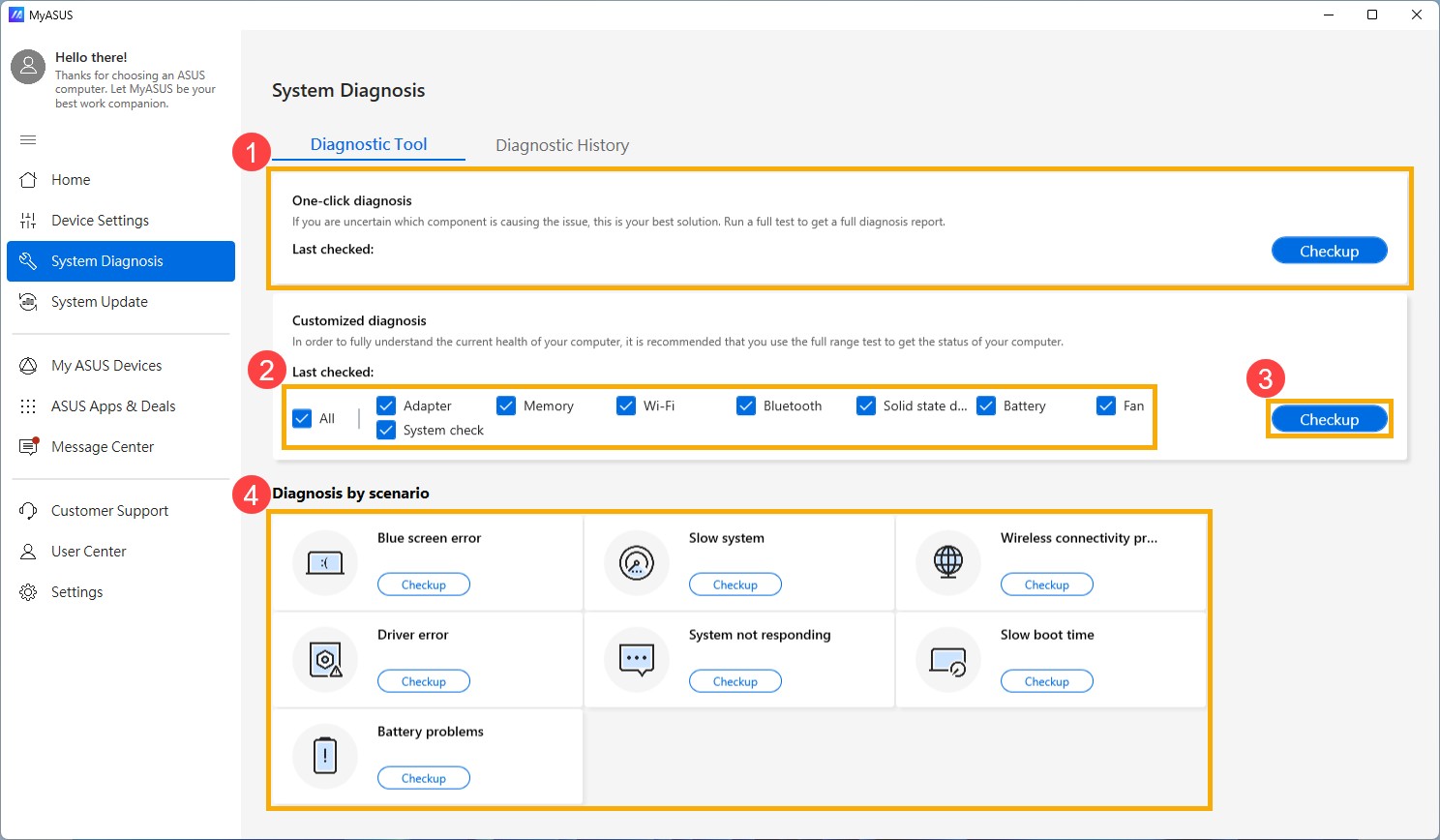
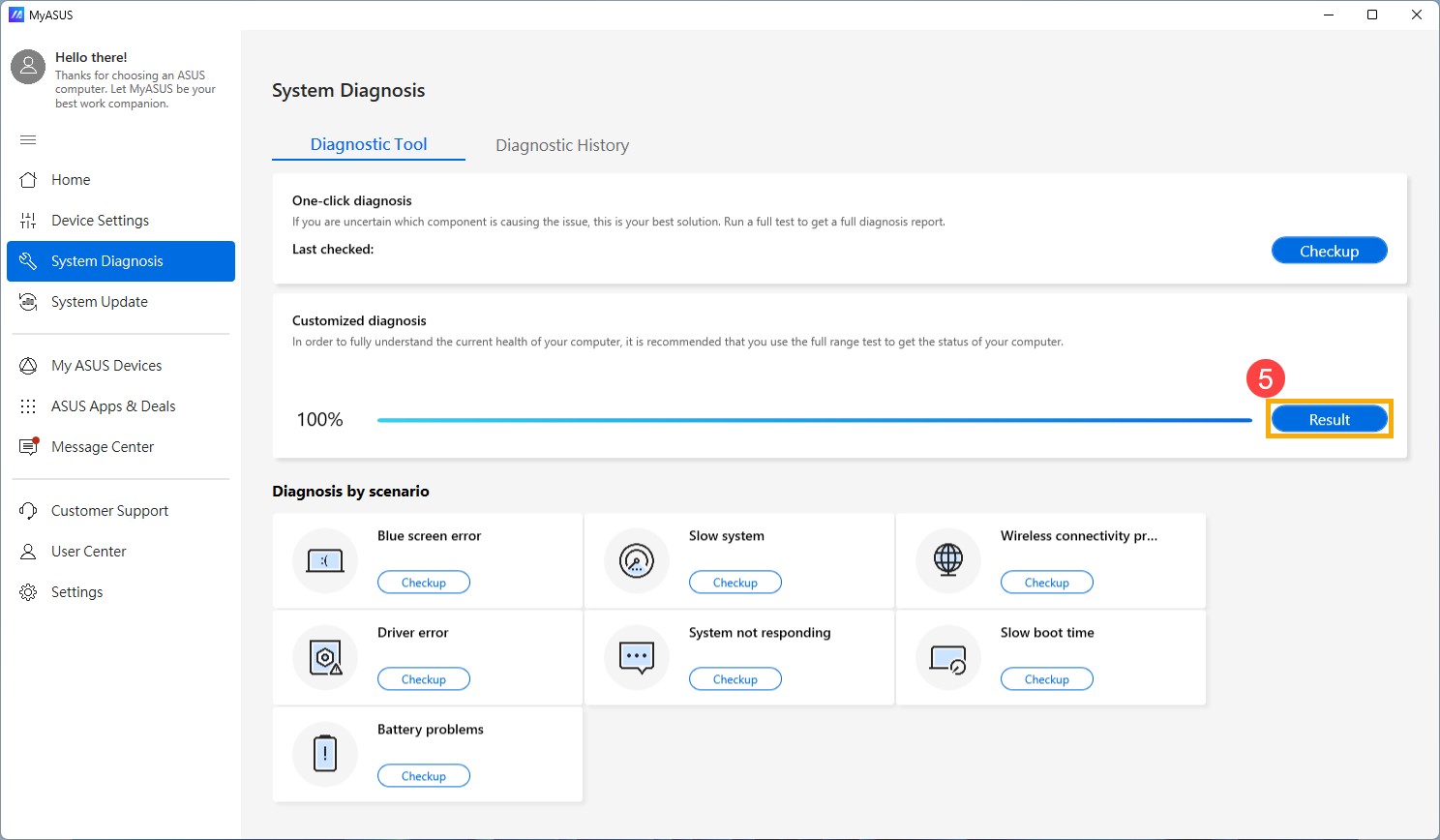
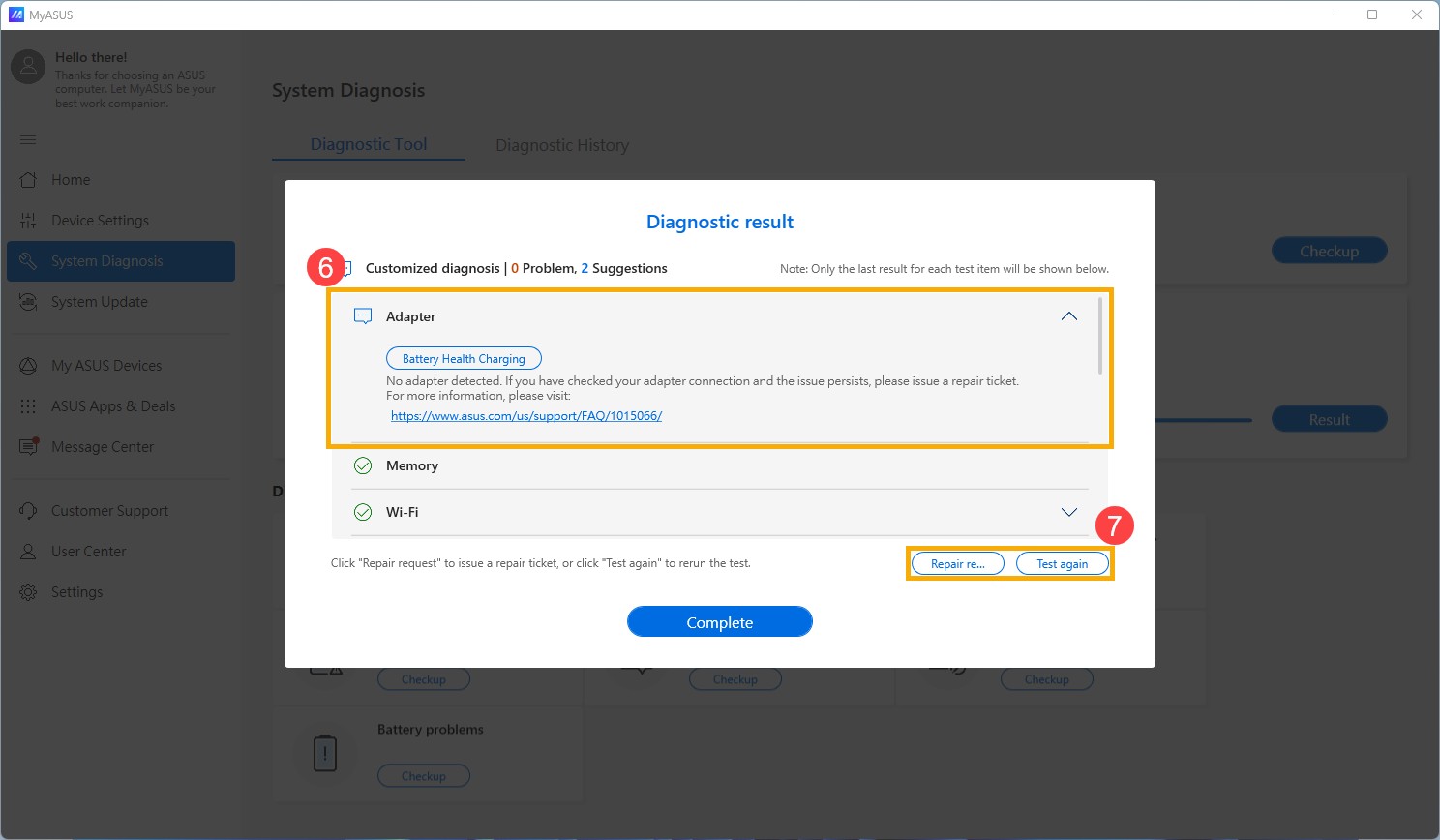
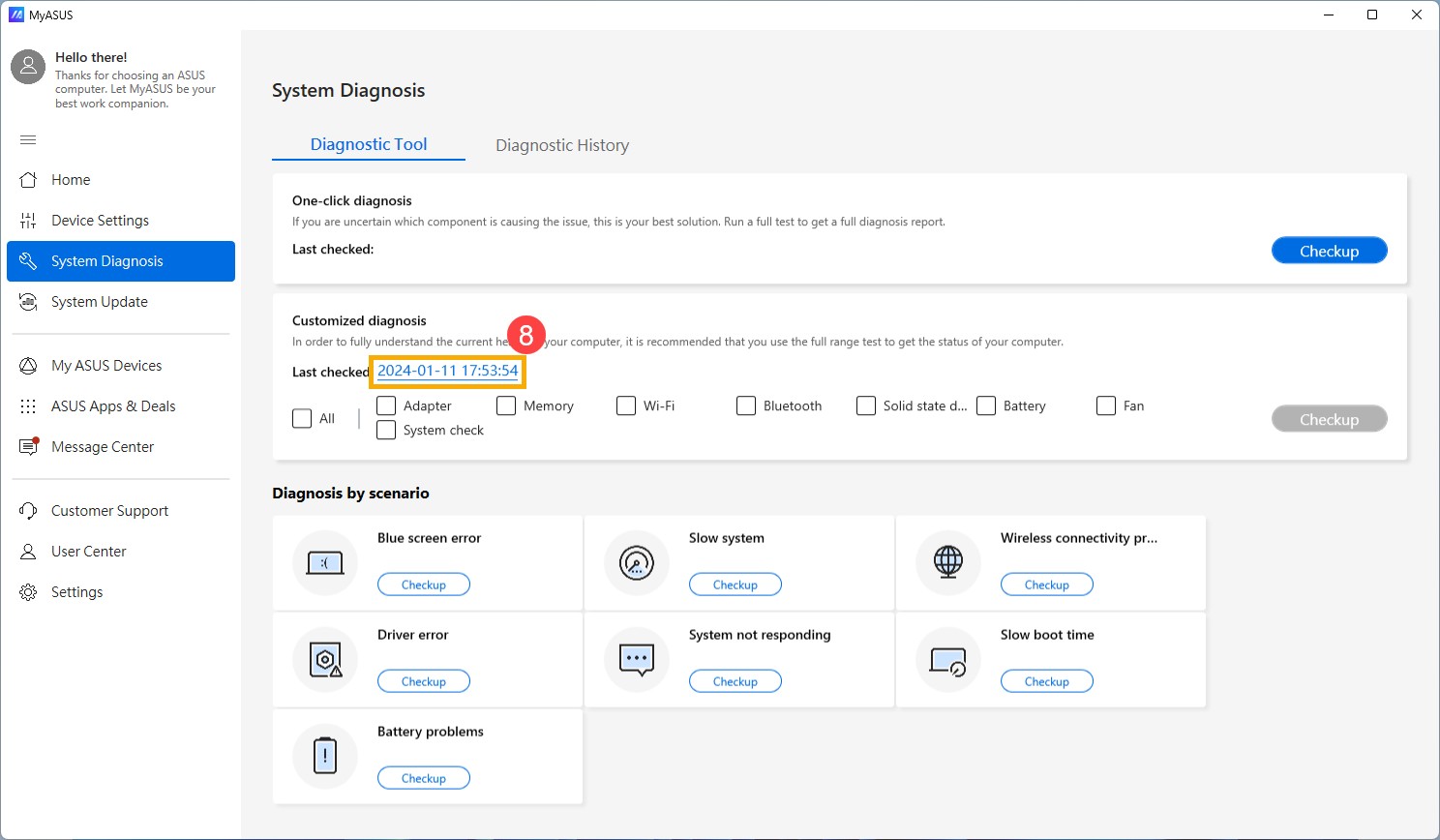
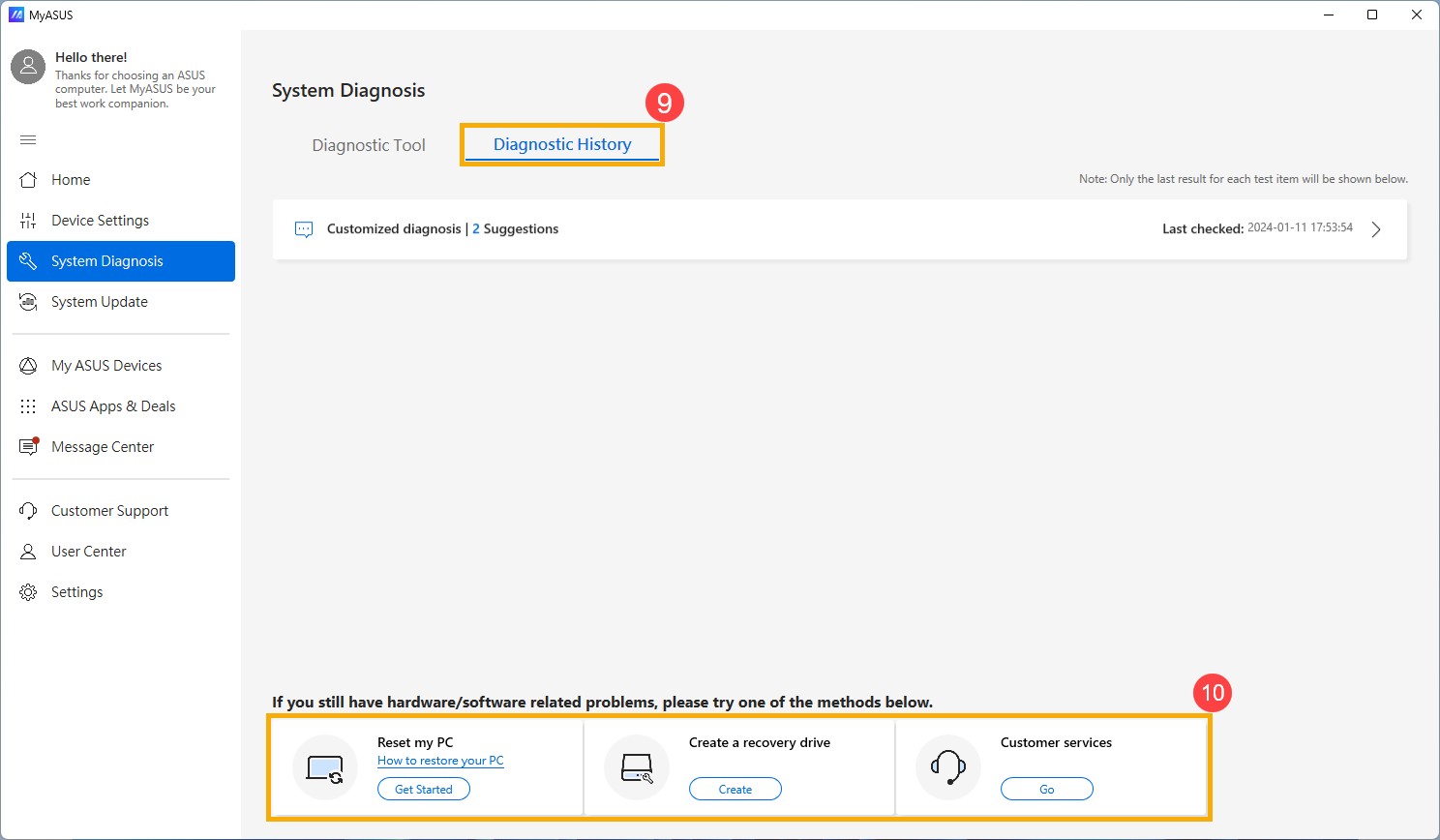



Note: The specific check items may vary depending on your ASUS device model.
Step-by-Step Guide: Running an ASUS System Diagnosis
Using the asus system diagnosis in MyASUS is a straightforward process. Follow these steps to initiate and interpret diagnostic tests:
-
Accessing System Diagnosis: Open the MyASUS application on your ASUS computer. You can usually find it in your Start Menu or by searching for “MyASUS.”
-
Navigating to Diagnostics: Within MyASUS, locate and click on the “System Diagnosis” or “Diagnostics” section. The exact wording might slightly vary depending on your MyASUS version.
-
Choosing a Diagnosis Type: You’ll be presented with the options for “One-click diagnosis,” “Customized diagnosis,” and “Diagnosis by scenario.”
-
One-click diagnosis: If you’re unsure where to start, select “One-click diagnosis.” Then, click the “Checkup” button to initiate a full system scan.
-
Customized diagnosis: For targeted testing, choose “Customized diagnosis.” Select the specific hardware components you want to examine by checking the boxes next to them. Click “Checkup” to begin the selected tests.
-
Diagnosis by scenario: If you’re experiencing a specific issue from the scenarios listed earlier (like “Slow System” or “Blue Screen Error”), click on the relevant scenario. This will automatically select the most appropriate check items for that problem. Click “Checkup” to proceed.
-
-
Running the Checkup: Once you’ve selected your diagnosis type and clicked “Checkup,” MyASUS will begin running the tests. The duration of the tests will vary depending on the components being checked and the overall system speed. Please be patient and allow the process to complete without interruption.
-
Viewing the Results: After the tests are finished, click the “Result” button to see the diagnostic report.
-
Interpreting the Report and Taking Action: The results page will display any errors detected during the tests.
- Error Items: Identifies the specific hardware components or areas where issues were found.
- Troubleshooting Suggestions: MyASUS provides advice and potential solutions to resolve the identified problems.
- Possible Approaches: Offers actionable steps you can take to address the errors, which might include driver updates, software adjustments, or hardware repair options.
If a hardware error is detected, MyASUS may provide options to create a repair ticket directly. You can also re-run the test to confirm the error is consistent.
Important Note: In some cases, troubleshooting steps might involve Windows Updates, which could trigger BitLocker recovery if you have encryption enabled. It’s highly recommended to save your BitLocker recovery key or temporarily disable BitLocker before performing Windows Updates. Refer to the ASUS support article for detailed instructions on managing BitLocker: https://www.asus.com/support/FAQ/1042922/.
-
Accessing Diagnostic History: To review past test results, click on “the last diagnosis time.”
-
Diagnostic History and Recovery Options: The “Diagnostic History” section provides a record of all previous system diagnoses. From this page, you also have access to crucial system recovery options:
- Reset my PC: Allows you to restore your system to a previous state, which can resolve software-related issues.
- Create a recovery drive: Enables you to create a bootable USB drive for system recovery in case of major system failures.
- Contact ASUS Customer Service: Provides a direct link to ASUS support channels if you need further assistance.
Click “How to restore your PC” for detailed instructions on the system restore process or “Get Started” to initiate the recovery process directly.
Frequently Asked Questions about MyASUS System Diagnosis
Q1: How do I check my MyASUS version?
A1: To find your MyASUS version, click the “Settings” icon (usually a gear icon) in the left-hand menu within MyASUS. Then, select “About” at the top of the Settings page. The “Current Version” will display your installed MyASUS version number.
Q2: Can I use MyASUS system diagnosis in airplane mode?
A2: Yes, most asus system diagnosis tests can be performed in airplane mode. The exceptions are the “Wi-Fi & Bluetooth” tests within “Customized diagnosis” and the “Wireless connectivity problems” scenario, as these require active wireless connections to function.
Q3: How do I request a repair after a hardware diagnostic in MyASUS?
A3: MyASUS simplifies the repair process. After running a hardware diagnostic, if an error is detected, the results screen will often provide an option to “Issue a repair ticket” or similar. For detailed instructions on submitting a repair request through MyASUS, please refer to this ASUS FAQ: How to apply the repair request after doing Hardware Diagnostic on MyASUS.
Q4: Why are some MyASUS features missing in my app?
A4: If you downloaded MyASUS from the Microsoft Store, you might encounter a version with limited functionality. Features like system diagnostics, software updates, and device settings require the “ASUS System Control Interface” driver to be installed and compatible with your device. If these features are missing, ensure you have the correct driver installed. For more information and troubleshooting steps, consult this ASUS article: Why can I only see the partial features in the MyASUS app?.
Take Control of Your PC’s Health with MyASUS
Asus system diagnosis within MyASUS is an invaluable tool for maintaining your ASUS PC’s health and performance. By proactively using these diagnostic features, you can identify and resolve issues quickly, prevent potential problems, and ensure a smooth and efficient computing experience. Download or update MyASUS today and unlock the full potential of your ASUS device!
Table of Contents:
Description of MyASUS System Diagnosis Scenarios
Step-by-Step Guide: Running an ASUS System Diagnosis
Frequently Asked Questions about MyASUS System Diagnosis
Take Control of Your PC’s Health with MyASUS